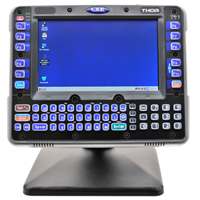What is OPOS?
A very common industry standard, OPOS enables programmers to write code once, but support any flavor of POS equipment (Star, Epson, Bixolon receipt printers, etc). Without it, developers would need to learn the specific command language for every single device manufacturer they wish to implement in their software, making integration a very long and painful process when one wants to support many products. For software vendors who want to be completely hardware independent, OPOS is one convenient way to go. Though each have separate purposes, the OPOS, JavaPOS, and POS for .NET standards fall under one collective name called UPOS (Unified Point of Sale), all of which is maintained by the NRF ARTS committee. Furthermore, OPOS isn’t just for receipt printer implementation; it supports 36 POS devices in total, including cash drawers, pole displays, pinpads, and etc.
Battery Life Tips for Mobile Computers
Get top performance from your Datalogic mobile computers by following these best practices for handling, charging, care and maintenance of installed battery bases.
Today’s mobile computers come with a full range of modern features which demand the best possible battery power to capitalize on. Whether you are using your mobile device for network communications, cell phone calls, internet access, barcode scanning, credit card transactions, GPS navigation, or color imaging, a dead battery will impact your productivity and ultimately affect total cost of ownership.
Datalogic has spent years studying the science of optimum mobile device performance, and we have compiled this documentation to help end users and administrators to employ proven battery management techniques to increase your operational success with our devices.
LXE THOR MN010 Vehicle Mount Computer
 The LXE Thor redefines the expectations of what a vehicle mounted computer can accomplish with a processing platform that is dramatically faster. Three patent-pending breakthrough features that enhance productivity and efficiency in ways never before imagined:
The LXE Thor redefines the expectations of what a vehicle mounted computer can accomplish with a processing platform that is dramatically faster. Three patent-pending breakthrough features that enhance productivity and efficiency in ways never before imagined:
- Field-replaceable front panel that gets you back on line if the touch-screen, keyboard or defroster fail
- Quick Mount Smart Dock allows one-handed move of units between vehicles to save cost and reduce down-time
- Ignition control makes the computer ready for work when you are
The Thor is designed for enterprises using forklifts, cranes, trucks and heavy machinery in warehousing, ports, manufacturing floor, natural resource, and trucking/transportation applications.
The Thor will begin shipping in April 2011.
Key Thor Benefits
State of the art processing platform
- Thor’s processing platform is dramatically superior to all other CE vehicle-mount computers in processing speed, RAM and flash.
- 802.11 a/b/g and Bluetooth 2.0 comes standard, and by adding WWAN w/GPS (available in Q3), the advantage of Thor over other vehicle-mount computers becomes overwhelming.
- Cold Storage configuration, indoor & outdoor displays, and true space diversity antennas for WiFi, contribute to a device ready for virtually any industrial environment.
Persistent Topology of Data and Barcodes
 Can barcodes represent the algebraic characterization, persistent homology?
Can barcodes represent the algebraic characterization, persistent homology?
University of Pennsylvania Professor Robert Ghrist thinks they might. He has posted a PDF pre-print of a paper titled Barcodes: The Persistent Topology of Data.
This article surveys recent work of Carlsson and collaborators on applications of computational algebraic topology to problems of feature detection and shape recognition in high-dimensional data. The primary mathematical tool considered is a homology theory for point-cloud data sets — persistent homology — and a novel representation of this algebraic characterization
— barcodes. We sketch an application of these techniques to the classification of natural images.
5 internet points to anyone who understands the paper.
Motorola MC9190-G vs. MC9090-G Mobile Computer Feature Comparison
The Motorola MC9190-G mobile computer builds on the successful MC9090-G, offering more processing power to support today’s applications, more scanning options, better scanning performance, government grade security, a higher resolution display and a more rugged touchscreen and scanner exit window. The following chart highlights all the technology advances in this next generation in the MC9000 Series.
| Feature | Motorola MC9090-G | Motorola MC9190-G | Benefit |
|---|---|---|---|
| Processor | Intel XScale PXA270 @624 MHz | Marvell PXA320 @ 806 MHz | Faster processing improves application performance and user productivity, translating into minutes or even hours saved each week. |
| Memory (RAM/ROM) |
|
256MB RAM/1 GB Flash | Major increase in memory improves application processing speed — with ample processing space, there is no need to swap programs in and out of memory during a transaction. |
| Operating System |
|
|
The latest in mobile operating systems allows your business to take advantage of the latest feature set, including increased flexibility, interoperability and security. |
| SD Expansion Slot | SD/MMC card up to 1GB | SD/MMC card up to 32GB | Larger expansion slot capacity provides ample storage for the largest applications. |
| Interactive Sensor Technology (IST) | No | Yes | Enables leading edge motion-based applications, including dynamic screen orientation, power management and free-fall event logging as well as access to accelerometer data for custom applications. |
| Scanning Options |
|
|
Provides more data capture options, including long-range capture of 1D and 2D barcodes. In addition, the four imager options all offer Motorola’s revolutionary imaging technology, which delivers stunning laser-like stunningperformance on both 1D and 2D barcodes. The degradation of 1D barcode scanning performance typical in today’s 2D imagers is eliminated, expanding data capture capabilities to include 2D barcodes as well as documents, imagesand signatures — without impacting user productivity or scanning accuracy. |
| FIPS 140-2 Certification | No | Yes | Certified for use in government applications. |
| Display | 3.7 in. QVGA mono or color for Windows CE
3.7 in. QVGA color only for Windows Mobile |
3.7 in. VGA color for all operating systems | Best-in-class 3.7 inch high-resolution backlit color VGA touchscreen display provides great readability in any lighting condition — from bright sunlight to total darkness. |
| Gorilla® Glass scanner exit Window | No | Yes | Increases the durability of the scanner exit window with glass that is virtually impervious to damage — including scratches. |
| Hardened touchscreen | Yes | Yes — with increased hardness | The increased hardness further improves resistance to wear and tear. |
| Integrated UHF RFID tag | No | Yes | Businesses that have deployed RFID can automatically track the movement and location of MC9190-G devices. Automated real-time inventory enables cost-effective compliance with accounting regulations such as FASB. And the ability to quickly and easily locate misplaced devices ensures that your devices are always available for workers on the next shift. Device utilization and worker productivity are increased, improving the return on investment. |
| Motorola Mobility Platform Architecture (MPA) | MPA 1.0 | MPA 2.0 | The latest Motorola MPA platform provides the latest best-in-class technology architecture, providing an extended lifecycle and future-proofing. In addition, the standardized platform preserves existing application investments by enabling easy and cost-effective porting of applications from other Motorola mobile computers. |
| Bluetooth Version | 1.2 | 2.1 with EDR (Enhanced Data Rate) | The latest Bluetooth technology provides a faster wireless connection to more device types (up to 3 Mbps) over a more secure connection. |
| Bluetooth Stacks | StoneStreet | StoneStreet or Microsoft | Select the stack that best meets mobility needs. |
| Swappable Operating Systems | No | Yes | The ability to send the MC9190-G to a Motorola Service Center to switch between CE and Windows Mobile operating systems eliminates the need to purchase new mobile computers to accommodate a future OS migration. |




